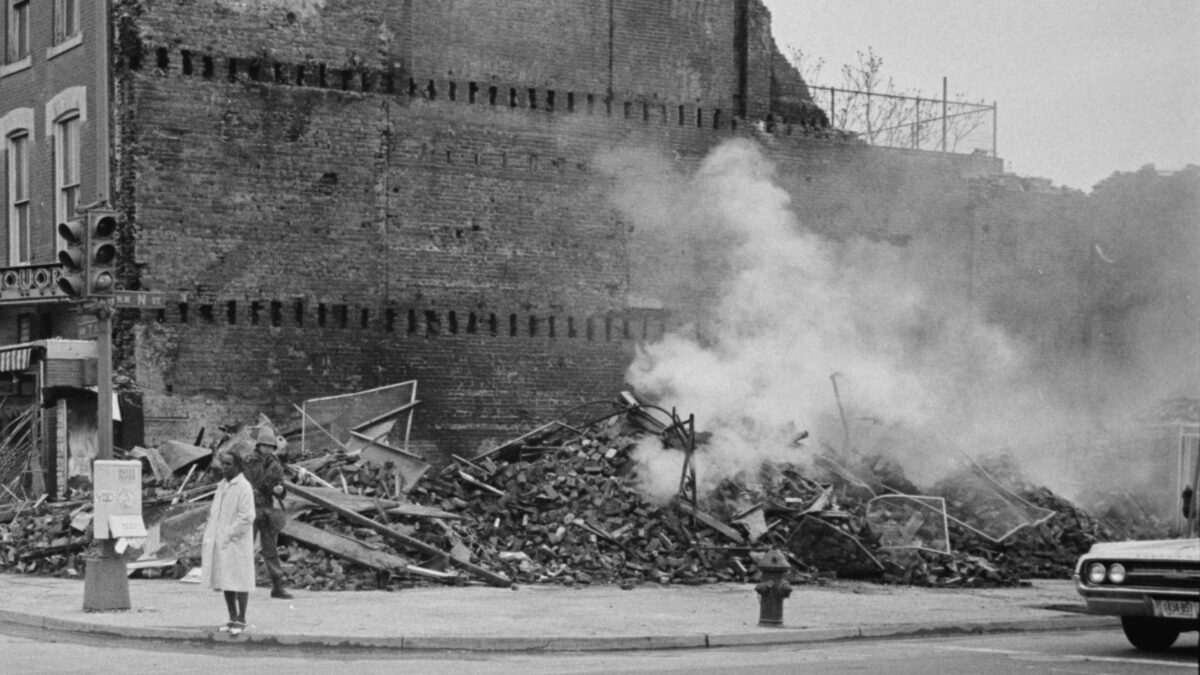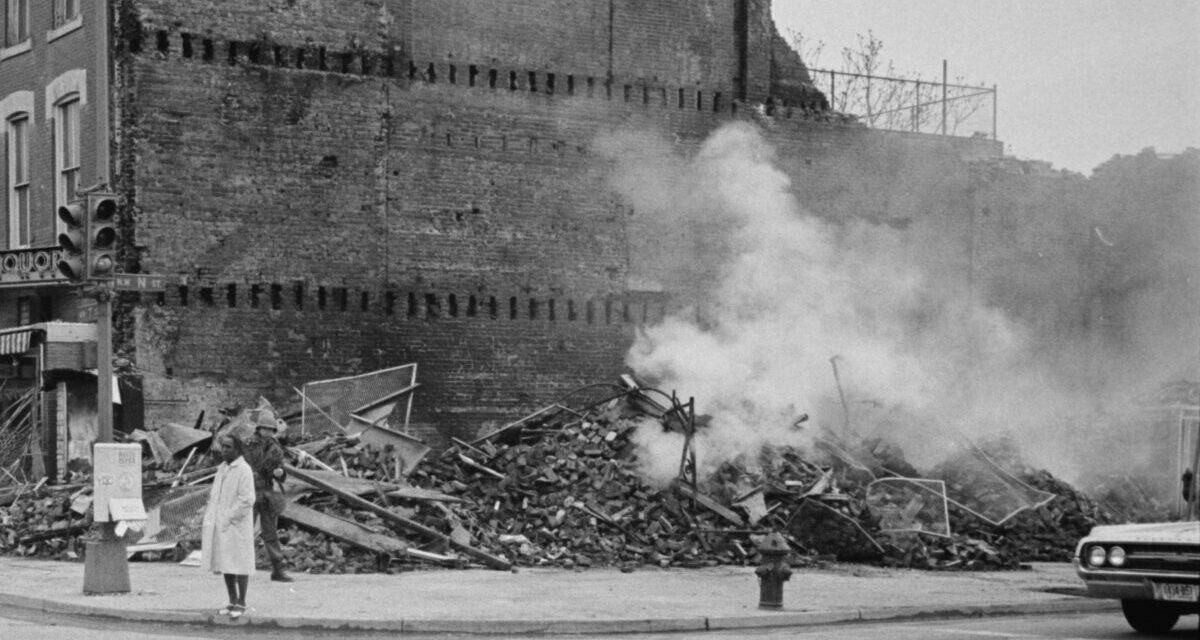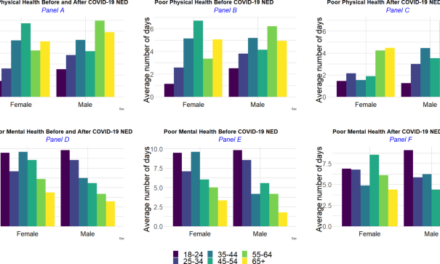
Aftermath of a riot in Washington, D.C., following Martin Luther King, Jr.’s funeral in 1968. Photography by Warren K. Leffler, via the Library of Congress.
Donovan X. Ramsey grew up in Columbus, Ohio, in the early 1990s. What policy and media makers labeled “the crack epidemic” unfolded around him, not in abstract statistics or through threats of moral panic, but in the homes and lives of his neighbors. In his home, crack was an open but undiscussed secret; “it was like growing up in a steel town where nobody talked about steel,” he writes in When Crack Was King. The rest of the country, or at least its white media, was in a moral panic. Experts spoke of soaring crime rates and a secondary epidemic of crack babies — crises that later, dispassionate studies renounced. So wrong was the destructive myth of the “crack baby” that even The New York Times, nearly two decades later, recanted its position in an editorial entitled “Slandering the Unborn.”
The narrative on crack — like so many narratives that have instrumentalized notions of public health and safety for racist ends — has begun to shift. But Ramsey realized the shift was taking place without any clarity on what, exactly, happened in the first place. “Around 2015, I decided to dig into the crack epidemic for myself. I’d had enough speculation and innuendo. I wanted to know the facts of crack — what it was, where it came from, and how it spread,” he writes.
Ramsey’s quest is deeper than any mere modern history: “I wanted to know why my community seemed so affected by it and not others. Who were we before crack?” He finds answers in the stories of four people whose lives intersect with the crack epidemic — a white man who grew up in poverty in Yonkers, the son of a crack-addicted father; a Black woman who spent thirty years as an addict, and now counsels other addicts; a former Baltimore mayor and early supporter of decriminalization; and a community activist who once one of Newark’s legendary dealers.
As he seeks to understand the causes and consequences of the crack epidemic, it’s clear Ramsey is looking in a new and much-needed way. “Perhaps the most salient element” of the crisis, he writes, “was grief, a deep despair that drenched Black America toward the end of the twentieth century.” In this outtake from When Crack Was King, which goes on sale later this month, Ramsey unpacks the relationship of another myth to that catalytic despair.
— Jina Moore Ngarambe for Guernica
Especially in northern cities, Blacks were boxed into lives of poverty, redlined into areas of concentrated poverty and further isolated when the federal government built interstate highways that separated them from their white neighbors. Their neighborhoods were patrolled by police departments who moved like occupying forces, with extreme prejudice and impunity. In these places — Los Angeles, New York, Newark, Detroit, and other cities — police brutality was a regular occurrence.
Those conditions birthed another movement. It existed alongside the same timeline as the Civil Rights Movement but wasn’t focused on inclusion and legal protection. It wanted power, the ability for Blacks to control their own lives and communities — including self-defense. This movement also excited Black America, segments that the Civil Rights Movement did not and in ways it couldn’t. The most prominent leader in this movement, of course, was Malcolm X who advocated for complete independence of Black Americans from a fundamentally wicked white society.
Malcolm grew up in poverty in Omaha, Milwaukee, and Lansing, Michigan. His parents had been Pan-Africanists and active in Marcus Garvey’s Universal Negro Improvement Association before his father died mysteriously — murdered by a local white supremacist group, according to rumors Malcolm heard growing up.
After Malcolm’s mother suffered a nervous breakdown, he became a ward of the state at thirteen years old and was placed in a foster home for a time before being sent to live with his older sister in Roxbury, a largely Black section of Boston. At twenty-one, Malcolm relocated from Boston to Flint, Michigan, for a short period before landing finally in Harlem, where he began a life of crime — drug dealing, running numbers, robbery, and pimping. It wasn’t until 1948 that he converted to Islam in prison after being convicted of larceny and breaking and entering in 1946.
Malcolm was paroled in August 1952 and almost immediately became a leader within the Nation of Islam. By the time of the March on Washington, he was the spokesman for the religious sect, which had 38 mosques spread across most major US cities and a membership in the tens of thousands. He rose to prominence condemning police brutality. He also preached self-defense and Black nationalism.
In his childhood across the industrial Midwest, his Pan-Africanist upbringing, his connection to prison and street life in Boston and Harlem, Malcolm had a markedly different upbringing than King and the main of the Civil Rights Movement. The difference perhaps cemented the difference in their ideologies. And tactics. Both men were aligned in their opposition to white supremacy but white America saw in King a legitimate leader and in Malcolm a zealot.
Perhaps the clearest example was the response to Malcolm’s assassination on February 21, 1965, at the age of thirty-nine. A New York Times editorial published the day after he was killed called him an “extraordinary and twisted man” who “turn[ed] many true gifts to evil purpose.” More epilogue than obituary, the write-up summed up Malcolm’s life as “strangely and pitifully wasted,” while blaming him for the mounting unrest in the country.
“This murder could easily touch off a war of vengeance of the kind he himself fomented,” the piece read. “It will take alertness and vigilance on the part of the police, especially in view of the ease with which lethal weapons are available, to make sure that violence is avoided.”
Malcolm’s murder wasn’t an event on the margins that threatened to creep into the main, however. And in its refusal to recognize Malcolm and what he represented as legitimate, The New York Times and others underestimated just how much his assassination would affect Black Americans, even those who disagreed with his ideology.
Responding to the news of Malcolm’s assassination, King wrote in a statement: “A man who lived under the torment of knowledge of the rape of his grandmother and murder of his father, and under the conditions of the present social order, does not readily accept that social order or seek to integrate into it. And so Malcolm was forced to live and die as an outsider, a victim of the violence that spawned him, and with which he courted through his brief but promising life . . . Surely the young men of Harlem and Negro communities throughout the nation ought to be ready to seek another way.”
They were not. Indeed, Malcolm’s assassination further radicalized the constituency he represented. It was, perhaps, the first in a series of assassination that would chart the slow death of the Civil Rights Movement, kindling for the fire to come.
With Malcolm’s assassination came greater militancy and urgency in some segments of Black America. As early as 1963, individual run-ins with police were erupting into larger conflicts in cities across America and the summer of 1964 saw seven riots — in Rochester, New York City, Philadelphia, Jersey City, Paterson, Elizabeth, and Chicago — events all initiated by police incidents of brutality against Blacks. However, the summer after Malcolm was assassinated saw a massive riot in Los Angeles, a city where he’d organized against police brutality years before.
The predominantly Black section of Watts went up in flames when residents took to the streets in response to reports that a 21-year-old resident had been pulled over, beaten, and arrested by members of the California Highway Patrol. The following year, 1966, riots broke out in Cleveland, Chicago and San Francisco.
By this point, it was clear that King’s dream and the hope it represented were beginning to fade from the American consciousness. In fact, in 1966 — just three years after his “I Have A Dream” speech” — King himself expressed his disillusionment in an interview with CBS’ Mike Wallace. It was in this interview that he called riots, “the language of the unheard.” “And, what is it that America has failed to hear?” he added. “It has failed to hear that the economic plight of the Negro poor has worsened over the last few years.”
On April 4, 1968, less than a month after the Kerner Commission report and only five years after his transcendent “I Have A Dream” speech, King was assassinated. He was shot in broad daylight on the balcony of the Lorraine Motel in Memphis. A sniper’s bullet entered the thirty-nine-year-old’s right cheek, breaking his jaw and several vertebrae as it traveled down his spinal cord, severing his jugular vein and major arteries before lodging in his shoulder. He was killed almost instantly.
There is maybe no better symbol for America’s relationship to its Black citizens than King, the most widely-respected member of the race, sprawled on a motel balcony in a pool of his own blood. He died a senseless and sudden death, one devoid of dignity — a Black death.
Hours after the news broke of King’s assassination, Senator Robert F. Kennedy, who was campaigning for president, shared it with the crowd at a rally in Indianapolis. In his remarks, likely with the riots of previous summers in mind, Kennedy warned the audience against divisiveness.
“For those of you who are Black and are tempted to be filled with hatred and distrust at the injustice of such an act, against all white people, I can only say that I feel in my own heart the same kind of feeling. I had a member of my family killed, but he was killed by a white man,” Kennedy said before offering a quote from an ancient Greek tragedian as consolation: “In our sleep, pain which cannot forget falls drop by drop upon the heart until, in our own despair, against our will, comes wisdom through the awful grace of God.”
Despite his eloquence and example, one suspects that Kennedy’s words did little to console. There was, after all, no comparison between King and John F. Kennedy. One was the 35th man elected as president of this country and the other was a prophet. Kennedy’s assassination marked the beginning of a new administration; King’s marked the beginning of the end of a movement.
Regardless, the improvised speech has been heralded as one of the greatest of the 20th century. It was credited with preventing riots in Indianapolis and probably did. Overshadowed by Kennedy’s stoic eloquence in the national memory, however, was the profound grief of the audience. His announcement that King was dead was met with a piercing shriek from the crowd, their screams making audible the profanity of a peaceable man’s violent end. That shriek was, however, but a whisper compared to the primal scream gurgling up elsewhere in the country.
Between the evening of April 4, the day King was assassinated, and Easter Sunday, April 14, 1968, more than 100 cities across thirty-six states and the District of Columbia rioted. Combined, forty-three men and women were killed, approximately 3,500 were injured, and 27,000 were arrested. Fifty-four cities suffered at least $100,000 in property damage, with DC and Baltimore topping the list at approximately $15 million and $12 million in damage, respectively.
Experts called it the greatest wave of social unrest since the Civil War. “Not until over 58,000 National Guardsmen and army troops joined local state and police forces did the uprisings cease,” wrote historian Peter Levy of the riots.
The event is not well-remembered in the American consciousness. It does not fit easily into the narrative of a triumphant Civil Rights Movement which erased the country’s racism. In fact, it points to the contrary. The Holy Week Uprising, as it’s called, suggests that Black Americans were so upset by King’s assassination, by what it represented, that news of it spurred an insurrection.
And it was in this fateful moment that the wave of hope finally broke for Black America.
Donovon X. Ramsey’s book, When Crack Was King, publishes this month by Penguin Random House.





